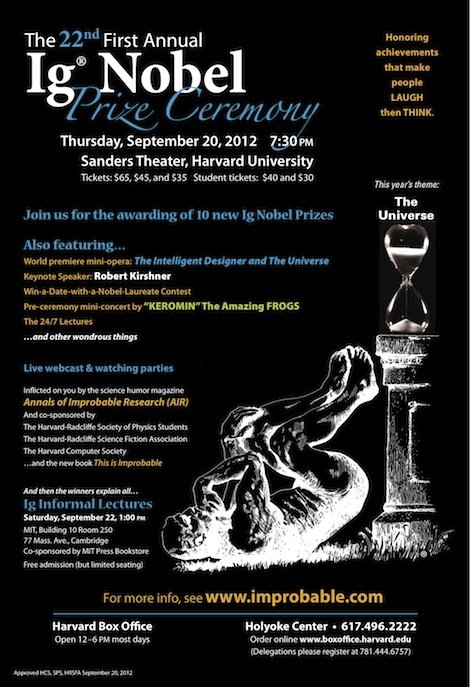
A British-American team that came up with an equation to predict the shape of a ponytail has earned itself an Ig Nobel.
Patrick Warren, Raymond Goldstein, Robin Ball and Joe Keller picked up their prestigious award at a sellout gala ceremony at Harvard University.
The Ig Nobel Prizes are an American parody of the Nobel Prizes and are given each year, usually in early October, for ten unusual or trivial achievements in scientific research.
Other 2012 winners included teams that studied how chimps could recognize each other from their behinds and why coffee will spill out of a moving mug.
But although some of this celebrated research might sound daft, much of it is intended to tackle real-world problems and gets published in peer-reviewed, scholarly journals.
Dr. Patrick Warren, who is a researcher for Unilever in the UK, said he was thrilled to pick up his Ig.
“I’m amazed that a piece of work I’ve done has attracted so much attention,” he said.
“My field, statistical physics, is not something that many will have heard of, so I’m really pleased we’ve done something that’s caught the imagination.”
His and his co-workers’ research produced what has become known as the “Ponytail Shape Equation”.
It takes into account the stiffness of the hair fibres on the head, the effects of gravity and the presence of the random curliness or waviness that is ubiquitous in human hair to model how a ponytail is likely to behave.

Together with a new quantity the team calls the Rapunzel Number, the equation can be used to predict the shape that hair will take when it is drawn behind the head and tied together.
“I’ve been working on this for a long time,” said Dr. Patrick Warren.
“At Unilever, as you can imagine, there is a lot of interest because we sell a lot of haircare products. But there are wider applications where you have a lot of fibres coming together, such as in fabrics.
“I’ve also wondered if we can contribute something to the whole area of computer animation. Hair, for example, is something that is very hard to make look natural in animated movies.”
Thursday’s Ig Nobel ceremony at Harvard’s Sanders Theatre was the 22nd since the American science humor magazine, Annals of Improbable Research, started the event.
The gala is always attended by real Nobel Laureates, who are tasked with handing out the prizes. Recipients get 60 seconds to make an acceptance speech. If they run over, a young girl will start to shout “boring”. Another tradition is for everyone in the theatre to throw paper planes.
The full list of 2012 Ig Nobel winners:
Psychology Prize: Anita Eerland and Rolf Zwaan (Netherlands) and Tulio Guadalupe (Peru/Russia/Netherlands) for their study Leaning to the Left Makes the Eiffel Tower Seem Smaller.
Peace Prize: The SKN Company (Russia) for converting old Russian ammunition into new diamonds.
Acoustics Prize: Kazutaka Kurihara and Koji Tsukada (Japan) for creating the SpeechJammer – a machine that disrupts a person’s speech by making them hear their own spoken words at a very slight delay.
Neuroscience Prize: Craig Bennett, Abigail Baird, Michael Miller, and George Wolford (US) for demonstrating that brain researchers, by using complicated instruments and simple statistics, can see meaningful brain activity anywhere – even in a dead salmon.
Chemistry Prize: Johan Pettersson (Sweden/Rwanada) for solving the puzzle of why, in certain houses in the town of Anderslöv, Sweden, people’s hair turned green.
Literature Prize: The US Government General Accountability Office for issuing a report about reports about reports that recommends the preparation of a report about the report about reports about reports.
Physics Prize: Joseph Keller (US), Raymond Goldstein (US/UK), Patrick Warren and Robin Ball (UK) for calculating the balance of forces that shape and move the hair in a human ponytail. Prof Keller was additionally given an Ig for work he contributed to on non-drip teapots in 1999 but for which he had been wrongly overlooked at the time.
Fluid Dynamics Prize: Rouslan Krechetnikov (US/Russia/Canada) and Hans Mayer (US) for studying the dynamics of liquid-sloshing, to learn what happens when a person walks while carrying a cup of coffee.
Anatomy Prize: Frans de Waal (Netherlands/US) and Jennifer Pokorny (US) for discovering that chimpanzees can identify other chimpanzees individually from seeing photographs of their rear ends.
Medicine Prize: Emmanuel Ben-Soussan and Michel Antonietti (France) for advising doctors who perform colonoscopies how to minimize the chance that their patients will explode.